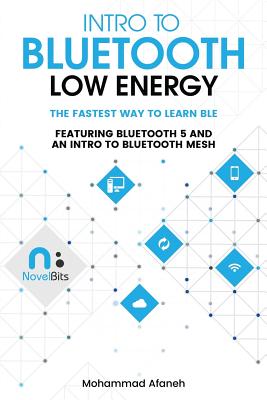Bluetooth Low Energy: The Developer's Handbook (Paperback)
暫譯: 藍牙低功耗:開發者手冊 (平裝本)
Robin Heydon
- 出版商: Prentice Hall
- 出版日期: 2012-10-28
- 售價: $2,260
- 貴賓價: 9.5 折 $2,147
- 語言: 英文
- 頁數: 368
- 裝訂: Paperback
- ISBN: 013288836X
- ISBN-13: 9780132888363
-
相關分類:
Bluetooth
-
相關翻譯:
低功耗藍牙開發權威指南 (簡中版)
已絕版
買這商品的人也買了...
-
 深入淺出設計模式 (Head First Design Patterns)
深入淺出設計模式 (Head First Design Patterns)$880$695 -
 大話設計模式
大話設計模式$620$490 -
 精通 Python 3 程式設計, 2/e (Programming in Python 3: A Complete Introduction to the Python Language, 2/e)
精通 Python 3 程式設計, 2/e (Programming in Python 3: A Complete Introduction to the Python Language, 2/e)$680$537 -
 LTE - The UMTS Long Term Evolution: From Theory to Practice, 2/e (Hardcover)
LTE - The UMTS Long Term Evolution: From Theory to Practice, 2/e (Hardcover)$4,640$4,408 -
 深入淺出 Python (Head First Python)
深入淺出 Python (Head First Python)$780$616 -
 Android 4.X 手機/平板電腦程式設計入門、應用到精通, 2/e (適用 Android 1.X~4.X)
Android 4.X 手機/平板電腦程式設計入門、應用到精通, 2/e (適用 Android 1.X~4.X)$520$411 -
 Debug Hacks 除錯駭客 -- 極致除錯的技巧與工具
Debug Hacks 除錯駭客 -- 極致除錯的技巧與工具$580$458 -
![ASP.NET 4.5 專題實務 [I]-C# 入門實戰篇-cover](https://cf-assets1.tenlong.com.tw/images/71291/medium/9789572240601_bc.jpg) ASP.NET 4.5 專題實務 [I]-C# 入門實戰篇
ASP.NET 4.5 專題實務 [I]-C# 入門實戰篇$780$616 -
 版本控制使用 Git, 2/e (Version Control with Git: Powerful tools and techniques for collaborative software development, 2/e)
版本控制使用 Git, 2/e (Version Control with Git: Powerful tools and techniques for collaborative software development, 2/e)$580$458 -
 無瑕的程式碼 - 敏捷軟體開發技巧守則 (Clean Code: A Handbook of Agile Software Craftsmanship)
無瑕的程式碼 - 敏捷軟體開發技巧守則 (Clean Code: A Handbook of Agile Software Craftsmanship)$580$452 -
 超圖解 Arduino 互動設計入門 (附 Arduino UNO R3 開發板)
超圖解 Arduino 互動設計入門 (附 Arduino UNO R3 開發板)$1,130$893 -
 Arduino UNO R3 開發板(副廠相容版)附傳輸線
Arduino UNO R3 開發板(副廠相容版)附傳輸線$400$380 -
 易讀程式之美學-提升程式碼可讀性的簡單法則 (The Art of Readable Code)
易讀程式之美學-提升程式碼可讀性的簡單法則 (The Art of Readable Code)$480$379 -
 BIM 建築資訊建模手冊, 2/e-寫給業主、專案經理、設計師、工程師以及承包商的 BIM 建築資訊建模指南(BIM Handbook, 2/e)
BIM 建築資訊建模手冊, 2/e-寫給業主、專案經理、設計師、工程師以及承包商的 BIM 建築資訊建模指南(BIM Handbook, 2/e)$1,500$1,185 -
 $408藍牙 4.0 BLE 開發完全手冊-物聯網開發技術實戰
$408藍牙 4.0 BLE 開發完全手冊-物聯網開發技術實戰 -
無瑕的程式碼 番外篇-專業程式設計師的生存之道 (The Clean Coder: A Code of Conduct for Professional Programmers)
$360$281 -
 無瑕的程式碼-敏捷軟體開發技巧守則 + 番外篇-專業程式設計師的生存之道 (雙書合購)
無瑕的程式碼-敏捷軟體開發技巧守則 + 番外篇-專業程式設計師的生存之道 (雙書合購)$940$700 -
 新世代員工和你想的不一樣─主管們,你頭痛了嗎?
新世代員工和你想的不一樣─主管們,你頭痛了嗎?$260$203 -
 透視 C語言指標-深度探索記憶體管理核心技術 (Understanding and Using C Pointers)
透視 C語言指標-深度探索記憶體管理核心技術 (Understanding and Using C Pointers)$480$379 -
 超圖解 Arduino 互動設計入門, 2/e
超圖解 Arduino 互動設計入門, 2/e$680$537 -
 Getting Started with Bluetooth Low Energy: Tools and Techniques for Low-Power Networking (Paperback)
Getting Started with Bluetooth Low Energy: Tools and Techniques for Low-Power Networking (Paperback)$1,615$1,530 -
 ASP.NET MVC 5 網站開發美學
ASP.NET MVC 5 網站開發美學$780$616 -
 精通 Python|運用簡單的套件進行現代運算 (Introducing Python: Modern Computing in Simple Packages)
精通 Python|運用簡單的套件進行現代運算 (Introducing Python: Modern Computing in Simple Packages)$780$616 -
 完整學會 Git, GitHub, Git Server 的24堂課
完整學會 Git, GitHub, Git Server 的24堂課$360$284 -
 TensorFlow + Keras 深度學習人工智慧實務應用
TensorFlow + Keras 深度學習人工智慧實務應用$590$460
商品描述
The First Complete Guide to Bluetooth Low Energy: How It Works, What It Can Do, and How to Apply It
A radical departure from conventional Bluetooth technology, Bluetooth low energy (BLE) enables breakthrough wireless applications in industries ranging from healthcare to transportation. Running on a coin-sized battery, BLE can operate reliably for years, connecting and extending everything from personal area network devices to next-generation sensors. Now, one of the standard’s leading developers has written the first comprehensive, accessible introduction to BLE for every system developer, designer, and engineer.
Robin Heydon, a member of the Bluetooth SIG Hall of Fame, has brought together essential information previously scattered through multiple standards documents, sharing the context and expert insights needed to implement high-performance working systems. He first reviews BLE’s design goals, explaining how they drove key architectural decisions, and introduces BLE’s innovative usage models. Next, he thoroughly covers how the two main parts of BLE, the controller and host, work together, and then addresses key issues from security and profiles through testing and qualification. This knowledge has enabled the creation of Bluetooth Smart and Bluetooth Smart Ready devices.
This guide is an indispensable companion to the official BLE standards documents and is for every technical professional and decision-maker considering BLE, planning BLE products, or transforming plans into working systems.
Topics Include
- BLE device types, design goals, terminology, and core concepts
- Architecture: controller, host, applications, and stack splits
- Usage models: presence detection, data broadcasting, connectionless models, and gateways
- Physical Layer: modulation, frequency band, radio channels, power, tolerance, and range
- Direct Test Mode: transceiver testing, hardware interfaces, and HCI
- Link Layer: state machine, packets, channels, broadcasting, encryption, and optimization
- HCI: physical/logical interfaces, controller setup, and connection management
- L2CAP: channels and packet structure, and LE signaling channels
- Attributes: grouping, services, characteristics, and protocols
- Security: pairing, bonding, and data signing
- Generic Access Profiles: roles, modes, procedures, security modes, data advertising, and services
- Applications, devices, services, profiles, and peripherals
- Testing/qualification: starting projects, selecting features, planning, testing, compliance, and more
商品描述(中文翻譯)
藍牙低能耗的第一本完整指南:它是如何運作的、能做什麼以及如何應用
藍牙低能耗(BLE)是一種徹底改變傳統藍牙技術的技術,能在從醫療保健到交通運輸等行業中實現突破性的無線應用。BLE運行在一個硬幣大小的電池上,可以可靠地運行多年,連接並擴展從個人區域網路設備到下一代感測器的所有設備。現在,這項標準的主要開發者之一撰寫了第一本全面且易於理解的BLE介紹,適合每位系統開發者、設計師和工程師。
Robin Heydon,藍牙SIG名人堂的成員,將之前散佈在多個標準文件中的重要資訊整合在一起,分享實施高效能工作系統所需的背景和專家見解。他首先回顧了BLE的設計目標,解釋了這些目標如何驅動關鍵的架構決策,並介紹了BLE的創新使用模型。接著,他徹底涵蓋了BLE的兩個主要部分,即控制器和主機如何協同工作,然後討論了從安全性和配置到測試和認證的關鍵問題。這些知識使得藍牙智慧型和藍牙智慧型準備設備的創建成為可能。
本指南是官方BLE標準文件不可或缺的伴侶,適合每位考慮BLE、計劃BLE產品或將計劃轉化為工作系統的技術專業人士和決策者。
主題包括:
- BLE設備類型、設計目標、術語和核心概念
- 架構:控制器、主機、應用程序和堆疊分割
- 使用模型:存在檢測、數據廣播、無連接模型和網關
- 物理層:調變、頻帶、無線通道、功率、容差和範圍
- 直接測試模式:收發器測試、硬體介面和HCI
- 連接層:狀態機、封包、通道、廣播、加密和優化
- HCI:物理/邏輯介面、控制器設置和連接管理
- L2CAP:通道和封包結構,以及LE信號通道
- 屬性:分組、服務、特徵和協議
- 安全性:配對、綁定和數據簽名
- 通用訪問配置文件:角色、模式、程序、安全模式、數據廣告和服務
- 應用程序、設備、服務、配置文件和外圍設備
- 測試/認證:啟動項目、選擇功能、計劃、測試、合規等











